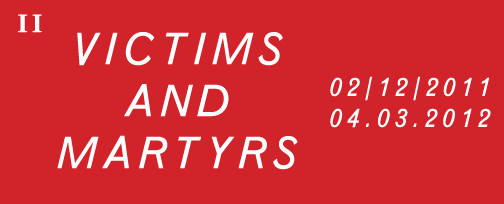Victims and martyrs
02 Dec 2011 - 04 Mar 2012
VICTIMS & MARTYRS
2 December, 2011 - March 4, 2012
Participating artists
Anita & Anita (Annika von Hausswolff and Lotta Antonsson), Conrad Botes, Juan Manuel Echavarría/Fundación Puntos de Encuentro, Runo Lagomarsino, Rabhi Mroué, Tanja Ostojić, Ruti Sela & Maayan Amir, Magnus Thierfleder and Artur Żmijewski
Victims and martyrs are in constant media focus. Every day there are reports of oppression, injustices and conflicts. But are these concepts not in themselves inextricably linked with the notion of victimisation and, by extension, potentially also, martyrdom?
The exhibition Victims and Martyrs examine the complexity and internal contradictions of this conceptual framework. The exhibiting artists interpret, activate and stage the landscape where victimisation and martyrdom takes place. Boundaries between victims and perpetrators dissolves and the premises that maintain and reproduce these roles are scrutinized.
How come some people are elevated to martyrs by some and regarded as terrorists by others? How do we relate to offenders who themselves are victims, and, vice versa, to victims when they also prove to be perpetrators? Why do some get such recognition after their deaths, while others at most, becoming a figure in the statistics?
2 December, 2011 - March 4, 2012
Participating artists
Anita & Anita (Annika von Hausswolff and Lotta Antonsson), Conrad Botes, Juan Manuel Echavarría/Fundación Puntos de Encuentro, Runo Lagomarsino, Rabhi Mroué, Tanja Ostojić, Ruti Sela & Maayan Amir, Magnus Thierfleder and Artur Żmijewski
Victims and martyrs are in constant media focus. Every day there are reports of oppression, injustices and conflicts. But are these concepts not in themselves inextricably linked with the notion of victimisation and, by extension, potentially also, martyrdom?
The exhibition Victims and Martyrs examine the complexity and internal contradictions of this conceptual framework. The exhibiting artists interpret, activate and stage the landscape where victimisation and martyrdom takes place. Boundaries between victims and perpetrators dissolves and the premises that maintain and reproduce these roles are scrutinized.
How come some people are elevated to martyrs by some and regarded as terrorists by others? How do we relate to offenders who themselves are victims, and, vice versa, to victims when they also prove to be perpetrators? Why do some get such recognition after their deaths, while others at most, becoming a figure in the statistics?

